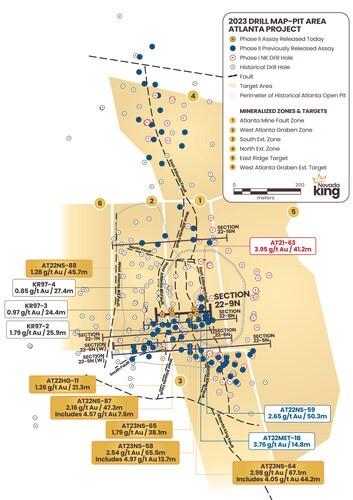
NEVADA KING INTERCEPTS HIGH-GRADE OXIDE GOLD AT ATLANTA INCLUDING 2.98 G/T AU OVER 67.1M, 2.54 G/T AU OVER 65.5M, AND 2.16 G/T AU OVER 47.3M

Nevada King Gold Corp. (TSX-V: NKG) (OTCQX: NKGFF) is pleased to announce assay results from six vertical reverse circulation holes recently completed at its Atlanta Gold Mine Project located 264km northeast of Las Vegas, Nevada, in the prolific Battle Mountain Trend.
Highlights:
| Hole No. | From (m) | To (m) | Interval (m) | Au (g/t) | Ag (g/t) | Notes | ||
| AT22HG-11 | 228.7 | 250.0 | 21.3 | 1.26 | 85.1 | Bottomed in Mineralization | ||
| AT22NS-87 | 169.2 | 216.5 | 47.3 | 2.16 | 140.2 | |||
| includes | 175.3 | 182.9 | 7.6 | 4.57 | 227.6 | |||
| AT22NS-88 | 169.2 | 214.9 | 45.7 | 1.28 | 162.0 | |||
| AT23NS-65 | 79.3 | 117.4 | 38.1 | 1.79 | 52.5 | |||
| AT23NS-58 | 42.7 | 108.2 | 65.5 | 2.54 | 62.9 | |||
| includes | 86.9 | 100.6 | 13.7 | 4.97 | 53.0 | |||
| AT23NS-64 | 41.2 | 108.2 | 67.1 | 2.98 | 62.1 | Bottomed in Mineralization | ||
| includes | 57.9 | 102.1 | 44.2 | 4.05 | 66.0 | |||
| Table 1: All holes released today. Mineralization occurs along sub-horizontal horizons generally dipping gently westward; true mineralized thickness in vertical holes is estimated to be between 85% and 95% of reported drill intercept length. | ||||||||
- Holes released today plotted on Section 22-9N were drilled across the high-grade feeder zone associated with several strands of a braided network of structures comprising the 150m-wide Atlanta Mine Fault Zone, which lies between the East Atlanta and West Atlanta Faults (see Figure 1). These vertical holes intercepted new areas of high-grade gold mineralization on this section that were not intercepted in historic drilling. These new high-grade areas were targeted based on Nevada King’s recent revised modelling of gold mineralization across this section line which differs significantly from historic interpretations.
- Shown in Figure 2, the highest gold grades occur within blocks between the Atlanta King and East Atlanta Faults as evidenced by AT23NS-58 and AT23NS-64 (Table 1) and nearby holes AT21-63 and AT22NS-59 (Table 2). Historical angle holes drilled by Goldfields, Kinross, and Meadow Bay largely passed beneath and missed this 40m-wide, shallow high-grade zone.
- In similar fashion, a 30m-wide block on the eastern side of the West Atlanta Fault is also host to higher-grades, as seen in AT22NS-87 and 88. A number of historical angle holes did intersect this zone, but very few of them fully sampled the complete mineralized thickness. Significant differences are apparent in gold grades and thicknesses in today’s NS-87 and NS-88 (47.3m @ 2.16 g/t and 45.7m @ 1.28 g/t) compared to Kinross angle holes KR97-3 and KR97-4 (24.4m @ 0.97 g/t and 27.4m @ 0.85 g/t).
- The upthrown “horst” block immediately west of the Atlanta King Fault typically hosts more moderate grades and thicknesses compared to the two high-grade zones on either side of it. However, AT22NS-65 tested this horst block and returned 1.79 g/t Au over 38.1m, which is generally thicker and higher grade compared to sections further south.
- Hole AT22HG-11, collared west of the West Atlanta Fault penetrated mineralized volcanics in the West Atlanta Graben target but was lost at a shallow depth, bottoming in mineralization. Drilling across the West Atlanta Graben along the western extension of line 22-9N will commence shortly, filling in a large information gap that currently exists within the historical drill pattern.
- Nevada King’s holes along 22-9N are very similar in grade and mineralized thickness to holes previously released along Sections 22-5N, 22-6N, 22-7N, and 22-08N. The same pattern of: (1) high-grade grabens between the East Atlanta and Atlanta King Faults, (2) the moderate grade horst block west of the Atlanta King fault, and (3) the high-grade graben block east of the West Atlanta Fault, is repeated southward along each section, demonstrating excellent continuity of mineralization.
Cal Herron, Exploration Manager of Nevada King, stated, “As our drill fences progress northward along the AMFZ we are seeing strong continuity in grade, thickness, and style of mineralization from section to section. We also start to see why many of the historical holes failed to pick up on the higher-grade mineralization localized in the numerous fault blocks and how this mineralization was largely missed by past explorers. The shallow high-grade mineralization immediately west of the East Atlanta Fault that we drilled into during our 2021 exploration program was completely missed by past explorers while the high-grade fault block along the east side of the West Atlanta Fault was under-represented in the historical drilling. Our new interpretation and geologic model is allowing us to effectively track both of these high-grade zones northward along the AMFZ, systematically defining the major fault components and associated mineralized blocks.”
| Hole No. | From (m) | To (m) | Interval (m) | Au (g/t) | Ag (g/t) | Notes |
| AT22NS-59 | 4.6 | 54.9 | 50.3 | 2.65 | 20.7 | |
| AT22MET-1B | 7.8 | 22.6 | 14.8 | 3.76 | 69.0 | Bottomed in Mineralization |
| AT21-63 | 7.6 | 48.8 | 41.2 | 3.95 | 27.3 | Bottomed in Mineralization |
| KR97-2 | 187.5 | 213.4 | 25.9 | 1.79 | 13.0 | |
| KR97-3 | 195.1 | 219.5 | 24.4 | 0.97 | 29.4 | |
| KR97-4 | 218 | 245.4 | 27.4 | 0.85 | 70.2 | |
| Table 2: Previously reported and historic holes used in Section 22-9N. AT22 series holes were drilled by Nevada King in 2022 while the AT21 series hole was drilled by Nevada King in 2021. KR97 series angle holes were drilled by Kinross in 1997. Mineralization occurs along sub-horizontal horizons generally dipping gently westward; true mineralized thickness in vertical holes is estimated to be between 85% and 95% of reported drill intercept length. | ||||||
Qualified Person
The scientific and technical information in this news release has been reviewed and approved by Calvin R. Herron, P.Geo., who is a Qualified Person as defined by National Instrument 43-101.
About Nevada King Gold Corp.
Nevada King is the third largest mineral claim holder in the State of Nevada, behind Nevada Gold Mines (Barrick/Newmont) and Kinross Gold. Starting in 2016 the Company has staked large project areas hosting significant historical exploration work along the Battle Mountain trend located close to current or former producing gold mines. These project areas were initially targeted based on their potential for hosting multi-million-ounce gold deposits and were subsequently staked following a detailed geological evaluation. District-scale projects in Nevada King’s portfolio include (1) the 100% owned Atlanta Mine, located 100km southeast of Ely, (2) the Lewis and Horse Mountain-Mill Creek projects, both located between Nevada Gold Mines’ large Phoenix and Pipeline mines, and (3) the Iron Point project, located 35km east of Winnemucca, Nevada.
The Company is well funded with cash of approximately $7.25 million as of April 2023.
The Atlanta Mine is a historical gold-silver producer with a NI 43-101 compliant pit-constrained resource of 460,000 oz Au in the measured and indicated category (11.0M tonnes at 1.3 g/t) plus an inferred resource of 142,000 oz Au (5.3M tonnes at 0.83 g/t). See the NI 43-101 Technical Report on Resources titled “Atlanta Property, Lincoln County, NV” with an effective date of October 6, 2020, and a report date of December 22, 2020, as prepared by Gustavson Associates and filed under the Company’s profile on SEDAR (www.sedar.com).
NI 43-101 Mineral Resources at the Atlanta Mine
| Resource
Category |
Tonnes
(000’s) |
Au Grade
(ppm) |
Contained Au
Oz |
Ag Grade
(ppm) |
Contained Ag
Oz |
| Measured | 4,130 | 1.51 | 200,000 | 14.0 | 1,860,000 |
| Indicated | 6,910 | 1.17 | 260,000 | 10.6 | 2,360,000 |
| Measured + Indicated | 11,000 | 1.30 | 460,000 | 11.9 | 4,220,000 |
| Inferred | 5,310 | 0.83 | 142,000 | 7.3 | 1,240,000 |

Figure 1. Location map for holes reported in this news release along drill section22-08N relative to the perimeter of the historical Atlanta Pit and footprint of the Gustavson 2020 NI 43-101 resource. Shallow drillholes on the mine dumps have been removed from the plot for clarity. (CNW Group/Nevada King Gold Corp.)

Figure 2. Cross section 22-09N looking north across the southern portion of the Atlanta Mine Fault Zone. Higher grade mineralization is concentrated within narrow fault blocks formed between the East Atlanta and Nevada King Faults. (CNW Group/Nevada King Gold Corp.)
MORE or "UNCATEGORIZED"
Kuya Silver Confirms High-Grade Silver-Gold Vein Mineralization at Umm-Hadid with Initial Drill Results up to 1483.9 g/t AgEq over 2 Metres
Kuya Silver Corporation (CSE: KUYA) (OTCQB: KUYAF) (FSE: 6MR1) is... READ MORE
First Phosphate Closes Final Tranche of Oversubscribed Private Placement
First Phosphate Corp. (CSE: PHOS) (OTCQX: FRSPF) (FSE: KD0) is... READ MORE
GFG Receives Final Payment from the Sale of its Rattlesnake Hills Gold Project
GFG Resources Inc. (TSX-V: GFG) (OTCQB: GFGSF) announces that i... READ MORE
Goliath Receives $1,730,882 Through Warrant Exercises, Inclusive Of Crescat Capital A Longtime Strategic And Cornerstone Shareholder
Goliath Resources Limited (TSX-V: GOT) (OTCQB: GOTRF) (FSE: B4IF)... READ MORE
Robex Pours First Gold at Kiniéro on Schedule and Budget
Highlights: Gold bar weighing 2.64 kilograms (85 oz) poured in th... READ MORE












